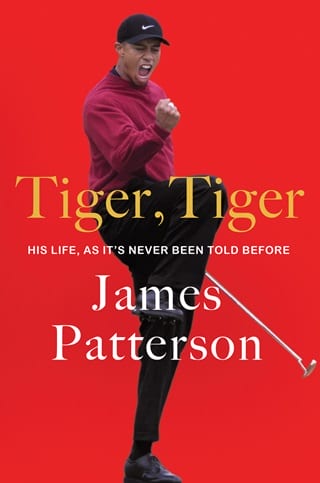Chapter 33
The 61st Masters
Augusta National Golf Club
Augusta, Georgia
April 9, 1997
No golf course places a greater premium on putting than Augusta National and its hyperfast roller-coaster greens.
What’s going on here? Tiger asks himself. In three days of practice rounds, a crucial element of his game is off. All of a sudden I’ve lost my putting. I just completely lost my feel.
It’s Wednesday, close to midnight, and the house Tiger has rented in town is uncomfortably quiet. Tida and Earl are both staying here—as are Earl’s physician and two of Tiger’s good friends, his childhood buddy Mike Gout and his former Stanford teammate Jerry Chang, who’ve been accompanying Tiger to various tournaments, including a February trip to the Asian Honda Classic, in Bangkok, Thailand, which Tiger won by ten strokes.
The camaraderie is something that Tiger—who’s missing what would be his junior year in college—has always appreciated about his old friends and teammates. “It felt like we were back in college,” Tiger says about having his buddies with him. “We had plenty of heated Ping-Pong games, and we also played video games and shot some hoops out back.”
But what he needs tonight is his dad’s advice.
From the foyer, Tiger can see a band of light beneath Earl’s door. He pulls his putter from his bag, grabs three balls, and climbs the stairs.
Earl is dozing, but he rouses to observe Tiger’s putting stance.
“How do you like my stroke, Pop?”
“I don’t.”
“What’s wrong with it?”
“Your hands are too low,” directs Earl from the bed. “Lift them up—get that little arch in your hands like you always do.”
The first professional golfer to ever earn a “verdant green” (Pantone 342) jacket at Augusta National was Sam Snead in 1949. The color was chosen by legendary golfer Bobby Jones, who personally handed the distinctive wool-and-polyester jacket to Snead.
The jackets, though hardly fashionable or luxurious, are now the most coveted item of clothing in all of professional golf. Last year’s champion, Nick Faldo, has won three (1989, 1990, 1996) and is aiming for a fourth.
Tradition dictates that the reigning Masters winner is paired with the reigning U.S. Amateur champion, so even though Tiger’s been a professional golfer for more than half a year now, he and Faldo are matched on April 10 in the first round of the 1997 Masters.
“He’s good for us 39, 40-year-olds,” Faldo told reporters about Tiger last October, before the TOUR Championship. “We have to do some extra pushups and situps to get to feeling like a 20-year-old again.”
By April, Faldo’s feeling a little less charitable about the media’s obsession. “Going in, it was, ‘What do you think of Tiger?’” Faldo says. “It was unbelievable. It was so total Tiger it was annoying. He came in with such major attention.”
Faldo has held the number one PGA ranking for ninety-seven straight weeks, yet it’s the rookie who arrives surrounded by a security force of eight policemen.
It’s an exciting matchup for spectators. But on the front nine, neither plays well.
Faldo shoots a 5-over 41. Tiger bogeys four of the first nine holes for 40. “You know, I felt a little out of sync,” Tiger tells Butch Harmon.
Mark O’Meara is coming off the 15th when he finds Tiger sitting on a bench.
O’Meara takes a seat next to his friend and asks a serious question. “Really?”
“Yeah, what?” Tiger replies.
“Dude, what’s going on, man?” O’Meara says. “You never play like this when you play with me at home. All you need to do is pretend like you’re playing against me. You shoot 59, you make birdies, you make holes-in-one. I mean, gimme a break.”
Fluff Cowan simply reminds Tiger that it’s only the front nine. “There’s a long way to go in this golf tournament,” the experienced caddie tells him. “Just hang in there, see if we can shoot something under par in the second nine, and we’ll be alright.”
Harmon sees Tiger’s initial struggles as a needed wake-up call. “It was kind of a slap in the face, like, ‘Hey, you’re this great player, but this course isn’t just going to let you take it. You’ve got to go out and earn this.’”
On the 10th, Tiger quiets his mental state, telling himself to let go of the excess force he’d been exerting on his swing and reminding himself that “you can’t think and swing at the same time.” That was no way to play—to really play golf. I needed the freedom that comes with playing. He tries to recall the sensations in his body from when he shot that perfect game at Isleworth. Just stick with this for nine holes and see if we can get back to even par. Just get to even par somehow.
Slowly Tiger raises his level on the back nine, hole by hole, eventually making eagle on the 15th and ending his first round with a 70. He “went out in 40 and back in 30,” comments Faldo, who finishes five back of his playing partner with a 75 and realizes the “special day” he’s witnessing—“the real beginning of Tigermania,” he says. “It was quite something.”
Jerry Chang and Earl watch the round from the TV in the rental house, then Chang—who’s acting as driver for the week—comes to pick Tiger up at the clubhouse. On the way back to the house with Mike Gout, the three stop at the Arby’s drive-through for some beef-and-cheddar sandwiches, then it’s back to the “fraternity-type atmosphere” at the house, with games of Ping-Pong and h-o-r-s-e to keep their buddy loose. Tiger is on fire; he wins every game.
On Friday, Tiger pairs with Paul Azinger in the second round.
Let’s just see what this guy’s all about, Azinger thinks—until he sees Tiger tee off on the second hole. “It was the most dead-straight rocket tee shot I’d ever seen in my life.”
On the back nine, Tiger drills his eagle putt on 13 and moves to the top of the leaderboard. As he steps to the 14th, CBS announcer Jim Nantz checks his watch and announces, “Let the record show, a little after 5:30 on this Friday, April the 11th, Tiger takes the lead for the very first time ever at the Masters.” This is going to happen a whole lot, Nantz suspects. Mark that point in history.
Tiger posts a 66 for a two-round score of 136 and a three-shot lead.
“To succeed [on Tour], you have to drive the ball well. You have to make putts, and you have to be the best wedge player,” Azinger says. Tiger had “all three. Even if he missed a fairway, he hit it a mile.”
Every night, Jerry Chang and Mike Gout pick Tiger up and take him to Arby’s, where they order more beef-and-cheddar sandwiches. “The boys were superstitious,” Tiger claims. “I didn’t argue.” The repetition is working.
“The only thing I want is a green jacket in my closet,” Tiger tells reporters when asked if he’s aiming to break the tournament’s 72-hole record. “I told my pop before we started I thought someone would make a run, shoot a 66 at the worst because the greens are soft and you can attack.”
On Saturday, April 12, Scottish golfer Colin Montgomerie is Tiger’s third Masters playing partner. “The pressure is mounting more and more,” Montgomerie says, believing that Tiger’s lead will crumble. “I’ve got more experience, a lot more experience, in major championships than he has.”
But Montgomerie’s third-round 74 doesn’t come close to Tiger’s 65, which puts him at 15 under par and nine strokes ahead of the current second-place contender, Costantino Rocca, from Italy.
“I thought I would beat him,” Montgomerie says. “I was wrong.” The Scotsman is now a believer. “There is no chance that it is humanly possible that Tiger will lose this tournament. No way.”
 Fullepub
Fullepub 



